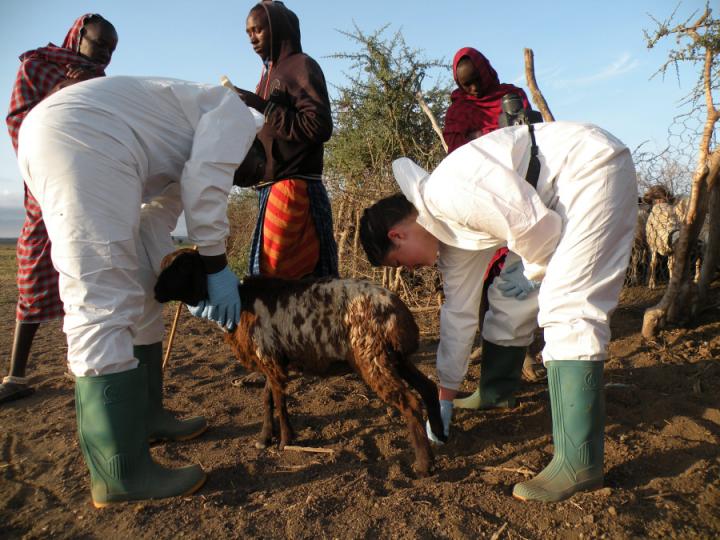New study uncovers source of mystery neurological disease devastating Tanzanian sheep and goats
Researchers have identified the source of a neurological disease in small ruminants in northern Tanzania as the dog tapeworm Taenia multiceps, opening the door for potential solutions.
by Vanessa Meadu
Pastoralist livestock keepers in Tanzania knew for some time that their sheep and goats were succumbing in large numbers to a neurological disease known locally as ormilo, but until recently this threat had gone largely unnoticed by the scientific community and the veterinary services. Now, researchers, from the University of Glasgow’s Institute of Biodiversity, Animal Health and Comparative Medicine (IBAHCM) and the Nelson Mandela African Institution of Science and Technology (NM-AIST), have identified the culprit as the dog tapeworm Taenia multiceps, opening the door for potential solutions.

The researchers had been undertaking a comprehensive study in Tanzania on livestock mortality, specifically on abortion as a cause of mortality, losses and infection, with funding from Supporting Evidence Based Interventions (SEBI) at the University of Edinburgh. That study is building a comprehensive baseline of evidence on abortion in Tanzania, which could eventually inform new interventions and investments in developing the country’s livestock sector. However, as the research progressed, reports of ormilo came up again and again from pastoral communities, echoing earlier reports of this syndrome as a major livestock health problem.
Following up on these reports, the researchers set out to investigate the origins of the disease, which causes a range of symptoms in sheep and goats including circling, disorientation, collapse, and ultimately death. The study, carried out in four villages in northern Tanzania, combined community surveys with detailed neurological assessments and post-mortem examinations to pinpoint the culprit.
Household questionnaires were a crucial starting point, and the researchers had the valuable support of local Livestock Field Officers and village leaders to engage with the community. The surveys revealed more than 90% of households had experienced at least one case of ormilo in the last year. The total number of reported cases added up to more than 10,000 animals, which translates to 25% of all sheep and goats kept in the four villages.
Ellen Hughes, a member of the research team in Tanzania led by Dr Tito Kibona of NM-AIST, shared her insights and experiences:
“We were taken aback by the scale of the problem, with these numbers highlighting the huge burden this condition is placing on pastoralist livestock keepers,” she writes in a story published on the Naturally Speaking blog
In addition, the researchers conducted post-mortem examinations on a number of affected animals and found large cysts caused by Taenia multiceps in the brain and spinal cord of in 82% of the animals tested. This tapeworm is carried by dogs but sheep and goats can become infected by eating eggs on contaminated pastures. The tapeworm larvae then migrate to the brain and form the cysts seen in cases of cerebral coenurosis.
These findings are significant, argues Ellen Hughes:
“Understanding the cause of ormilo was […] a vital first step in order to develop control strategies to protect pastoral livelihoods and ensure food security for vulnerable communities in Tanzania and beyond,” she writes in her blog story.
The SEBI-Tz research team are now working with partners in Tanzania to understand how widespread the disease problem is, and better quantify the economic impacts of this infection. The team are currently exploring a number of possible biosecurity interventions including safe disposal of infected carcasses and regular de-worming of dogs that could prevent the transfer of tapeworm between dogs and small ruminants.
At the same time, data generated from the abortion surveillance platform continues to provide key information on the causes, incidence and impact of cattle and small ruminant mortality in northern Tanzania. These developments show the importance of comprehensive data collection using a mix of quantitative and qualitative methods, and the need for more long-term studies on animal health and productivity.
The research has been published in the Veterinary Record:
Hughes, EC., Kibona, TK., de Glanville, WA., Lankester, F., Davis, A., Carter, RW., de Jong, RMF., Nyasebwa, OM., Claxton, JR., Cleaveland, S., Allan, KJ. (2019) Taenia multiceps coenurosis in Tanzania: a major and under-recognised livestock disease problem in pastoral communities. Veterinary Record 184, 191.
Vanessa Meadu is the Communications and Knowledge Exchange Specialist for the Supporting Evidence Based Interventions program, based at the University of Edinburgh’s Royal (Dick) School of Veterinary Studies.

